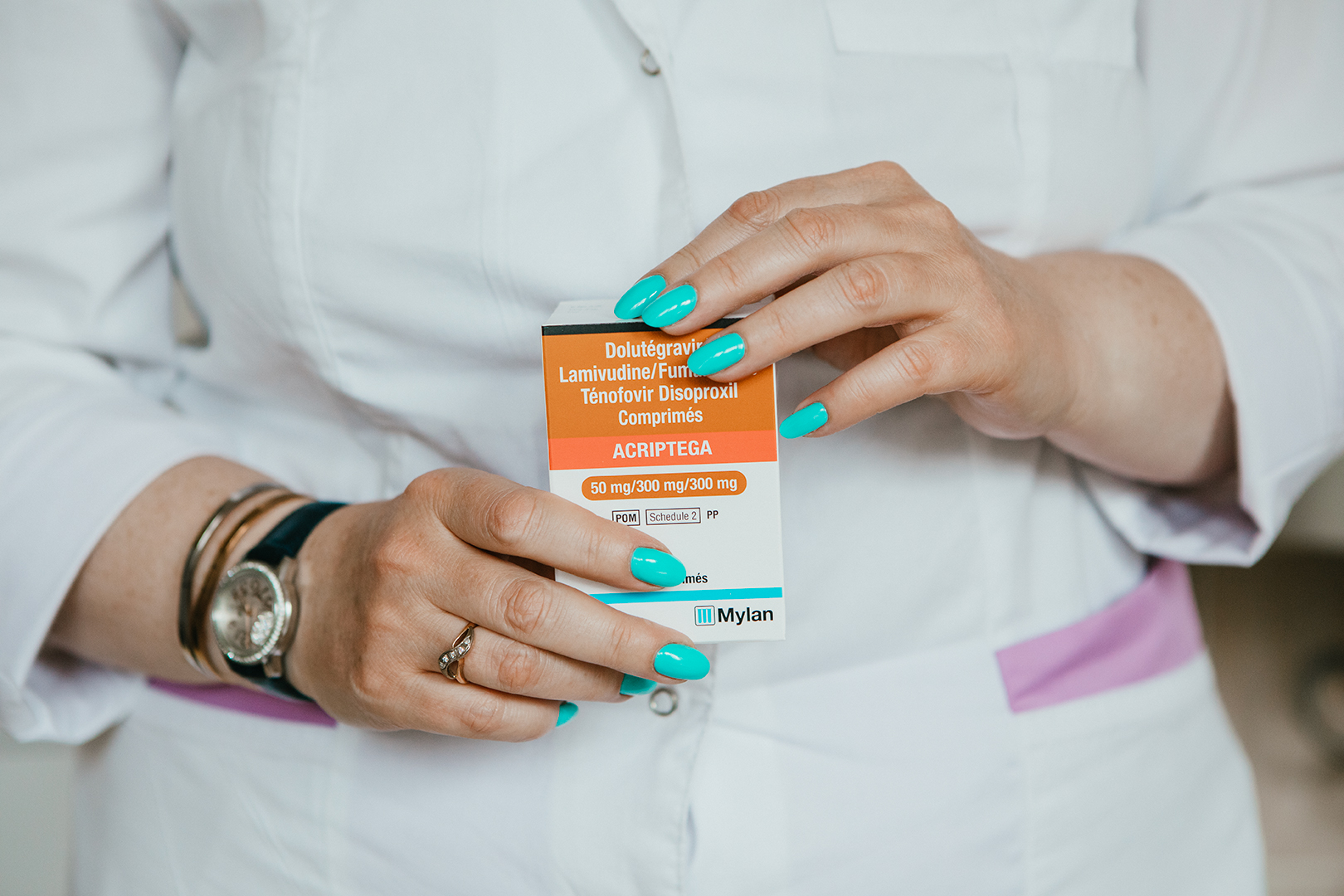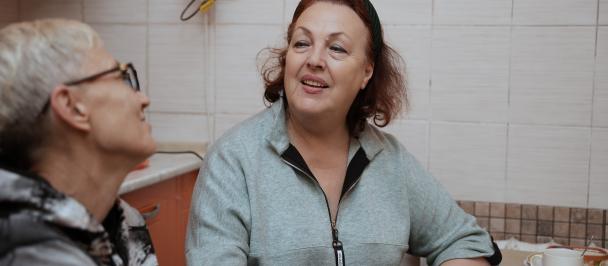When the first case of HIV infection was reported in Belarus in 1987, patients had little hope. With no effective treatment available, they faced debilitating illness and social isolation. Following decades of vigorous research and hard work, the country made impressive progress in treating the infection and establishing a well-functioning HIV infrastructure.
Belarus' HIV Treatment Story: Progress and Challenges
January 13, 2024

United Nations Development Program in Belarus is the main recipient of the Global Fund to Fight AIDS, Tuberculosis and Malaria's grant in the country
There are 24 887 people living with HIV in Belarus today. The majority of them have access to comprehensive care and are observed at HIV counselling and treatment facilities or consultation rooms at their local health care clinics.
Oleg Skripko, the Chief Consultant on treating HIV at the Ministry of Health of the Republic of Belarus, and Marina Gorovaya, the Head of the HIV Councelling and Treatment Department at the City Clinical Infectious Diseases Hospital in Minsk, have been at the forefront of combatting HIV for many years. Their stories showcase the success of modern medicine while also reminding us of the challenges that remain.

Oleg Skripko, Deputy Chief of the Ambulatory Care at the City Clinical Infectious Diseases Hospital in Minsk
Oleg Skripko first encountered HIV in 1990 when an infected child was admitted to the Children's Infectious Diseases Hospital where he was working at the time. There were no clinical guidelines in place at the time for delivering medical care to HIV patients, so the mother and infant were placed in an isolation ward that doctors entered wearing hazmat suits. The first HIV medicines were extremely harmful to the body, and some treatments resulted in severe neurological disorders in patients.

Marina Gorovaya, Head of the HIV Councelling and Treatment Department at the City Clinical Infectious Diseases Hospital in Minsk
Marina Gorovaya began working with HIV-positive people in 2008. At the time, only patients with a CD4 cell count of less than 200 got antiretroviral medication (ART) in accordance with WHO recommendations. Such a reduction in cells responsible for the immune system's response to pathogens puts people at a high risk of developing opportunistic infections and life-threatening diseases. Nonetheless, many patients with a favorable course of disease have more than 500 CD4 cells in 1 ml of blood, whereas a healthy person has 800-1200.
Marina recalls that all patients with HIV were assigned the first-degree disability and were instantly diagnosed with AIDS - the final stage of HIV infection. However, from the moment of infection with HIV to the development of AIDS, it can take an average of 7 to 15 years, depending on lifestyle, health, quality of diet, environment, and other factors.
— I work with a patient who was diagnosed with HIV in 1987. She is now over 50 and is still able to work even though she initially refused the diagnosis, was treated with unconventional methods, and started antiretroviral therapy rather late. At the start of the outbreak, some people were "lucky" enough to contract the less aggressive African strain of the virus. We now know that the time of infection and the general state of health are important factors. In some cases, the immune system deteriorates in a few years, while in others, it takes 12 years, — tells Marina Gorovaya.

UNDP in Belarus assists with the procurement of diagnostic materials and medicines for treating the HIV-infection
The HIV treatment protocols in Belarus were changed in 2018. Since then, every HIV-positive person has been entitled to free antiretroviral therapy from the moment they are diagnosed. All regions of Belarus are moving towards the strategic goal of the Joint United Nations Program on HIV/AIDS (UNAIDS): 95-95-95 targets. This strategy implies that by 2026, 95% of people living with HIV will know their HIV status; 95% of people who know their HIV status will receive treatment; 95% of people receiving HIV treatment will not have a detectable viral load.
Belarusian infectious disease specialists work closely with all relevant international organizations, and this is bearing fruit. Marina Gorovaya believes that by implementing all WHO recommendations and following the trend towards pre-exposure prophylaxis, Belarus is achieving European-level results.

With funding from the Global Fund, UNDP in Belarus supports NGOs working with people most vulnerable to the HIV infection.
While physicians are involved in the diagnosis and treatment, the epidemiologists focus on preventing the spread of the infection. Many attempts are made to locate people living with HIV, get them to healthcare facilities, and convince them to start treatment.
Success depends on the coordinated work of all parties involved, including the non-governmental organizations providing prevention services and support for people living with HIV. Peer consultants with special training play an essential role in this effort. They now have their own premises in the Minsk HIV Counselling and Treatment Unit.

UNDP has organized contactless ART delivery during the COVID-19 pandemic
Despite significant progress, Belarus continues to face challenges in the fight against HIV and AIDS. As a result of the COVID-19 pandemic, the number of advanced forms of HIV infections has increased. Many patients developed pneumocystis pneumonia, which is common in HIV-positive people with weak immune systems and is similar to pneumonia caused by COVID-19.
Marina recalls that doctors were so immersed in the fight against COVID-19 that their focus shifted away from HIV diagnosis. People also avoided healthcare institutions in fear of getting infected. To solve the problem, UNDP with the support of the Global Fund has successfully organized contactless ART delivery to patients in need. This practice continues today.

Most patients diagnosed with HIV-infection for the first time are above the age of 30
Marina notes that her patients are most afraid of having their secrets disclosed, but now it has become easier to work with them. There is trust that their personal information will not be shared outside the doctor’s office.
According to the data for the period from 1987 to 2023, the most common way of HIV transmission is sexual (68%), with parenteral transmission though intravenous drug administration accounting for 29.9%. Notably, the proportion of those infected through sexual contact is increasing, reaching 83.2% in 2023.
— It is more distressing for people to get infected through sexual contact. It’s easier for them to believe they were exposed in a manicure salon or during surgery. Sometimes, people are simply unlucky. They could have an unfortunate love affair and turn out to be HIV-positive, — comments Oleg Skripko.
— Seemingly successful and confident people come to our office and then confess how they felt when they first came to a doctor. They thank us for the words of support we shared, assuring them they would be alive and healthy. It is very important for us to show from the start that our facility is a safe space. Those who come to us must be treated as individuals, not merely patients. They feel respected when a doctor pays attention and remembers the stories of their patients, - adds the doctor.
Marina Gorovaya believes that the work of infectious disease specialists involves more psychology than medicine. An individual approach is important in solving mental health issues associated with accepting an HIV diagnosis. She is especially happy when her patients give birth to healthy children:
— We have girls that were diagnosed in the early 2000s and then have completely given up on their personal lives. We live through all 9 months of worries and fears with those women that dare to get pregnant. But then they cry with happiness, and it is priceless.

 Locations
Locations



